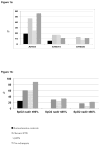Hypertension, snoring, and obstructive sleep apnoea during pregnancy: a cohort study
- PMID: 24888772
- PMCID: PMC4241143
- DOI: 10.1111/1471-0528.12885
Hypertension, snoring, and obstructive sleep apnoea during pregnancy: a cohort study
Abstract
Objective: To assess the frequency of obstructive sleep apnoea among women with and without hypertensive disorders of pregnancy.
Design: Cohort study.
Setting: Obstetric clinics at an academic medical centre.
Population: Pregnant women with hypertensive disorders (chronic hypertension, gestational hypertension, or pre-eclampsia) and women who were normotensive.
Methods: Women completed a questionnaire about habitual snoring and underwent overnight ambulatory polysomnography.
Main outcome measures: The presence and severity of obstructive sleep apnoea.
Results: Obstructive sleep apnoea was found among 21 of 51 women with hypertensive disorders (41%), but in only three of 16 women who were normotensive (19%, chi-square test, P=0.005). [Author correction added on 16 June 2014, after first online publication: Results mentioned in the abstract were amended.] Non-snoring women with hypertensive disorders typically had mild obstructive sleep apnoea, but >25% of snoring women with hypertensive disorders had moderate to severe obstructive sleep apnoea. Among women with hypertensive disorders, the mean apnoea/hypopnoea index was substantially higher in snorers than in non-snorers (19.9±34.1 versus 3.4±3.1, P=0.013), and the oxyhaemoglobin saturation nadir was significantly lower (86.4±6.6 versus 90.2±3.5, P=0.021). Among women with hypertensive disorders, after stratification by obesity, the pooled relative risk for obstructive sleep apnoea in snoring women with hypertension compared with non-snoring women with hypertension was 2.0 (95% CI 1.4-2.8).
Conclusions: Pregnant women with hypertension are at high risk for unrecognised obstructive sleep apnoea. Although longitudinal and intervention studies are urgently needed, given the known relationship between obstructive sleep apnoea and hypertension in the general population, it would seem pertinent that hypertensive pregnant women who snore should be tested for obstructive sleep apnoea, a condition believed to cause or promote hypertension.
Keywords: Hypertension; obstructive sleep apnoea; pregnancy; snoring.
© 2014 Royal College of Obstetricians and Gynaecologists.
Conflict of interest statement
The other authors have indicated no financial conflicts of interest.
Figures

Comment in
-
Sleep-disordered breathing in pregnancy: a brief summary of current knowledge.BJOG. 2014 Dec;121(13):1694. doi: 10.1111/1471-0528.12888. Epub 2014 May 30. BJOG. 2014. PMID: 24889020 Free PMC article. No abstract available.
References
-
- Duley L. The global impact of pre-eclampsia and eclampsia. Semin Perinatol. 2009;33(3):130–7. - PubMed
-
- Liu A, Wen SW, Bottomley J, Walker MC, Smith G. Utilization of health care services of pregnant women complicated by preeclampsia in Ontario. Hypertens Pregnancy. 2009;28(1):76–84. - PubMed
-
- Report of the National High Blood Pressure Education Program Working Group on High Blood Pressure in Pregnancy. American journal of obstetrics and gynecology. 2000;183(1):S1–S22. - PubMed
-
- World Health Report 2005: Make every mother and child count. Geneva: WHO; 2005. - PubMed
-
- Fraser A, Nelson SM, Macdonald-Wallis C, Cherry L, Butler E, Sattar N, Lawlor DA. Associations of pregnancy complications with calculated cardiovascular disease risk and cardiovascular risk factors in middle age: the Avon Longitudinal Study of Parents and Children. Circulation. 2012;125(11):1367–80. - PMC - PubMed
Publication types
MeSH terms
Grants and funding
LinkOut - more resources
Full Text Sources
Other Literature Sources
Medical

